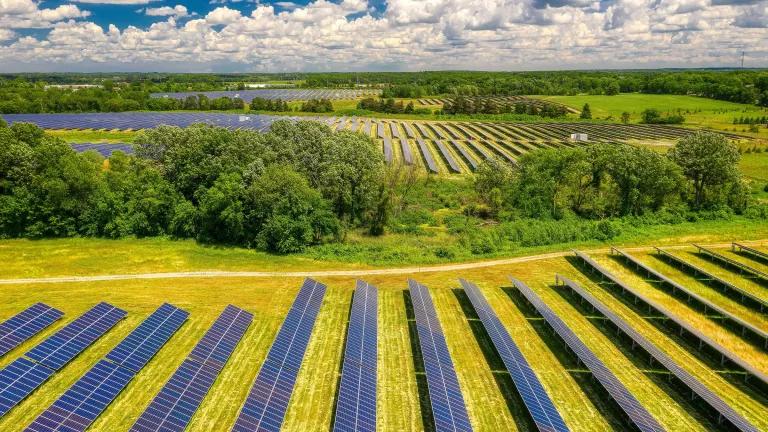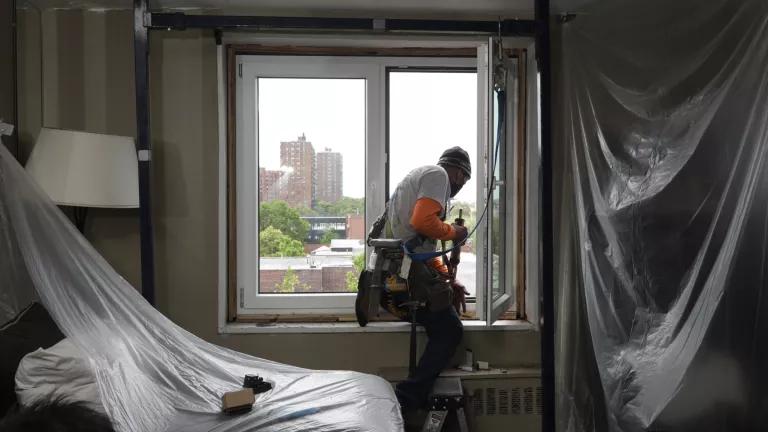Adjusting A/C and Other Energy Use Saves Lives

Summer is sweltering. And air conditioning cools us down. But at what cost?
That is one of the questions a team of scientists at the University of Wisconsin-Madison set out to answer in a new study of energy efficiency. Their conclusion? The less electricity we use to run air conditioning (A/C) and other appliances, the less unhealthy air pollution is released by power plants—and as a result, hundreds of premature deaths could be avoided each year.
The new peer-reviewed study published in the journal Environmental Science & Technology, is the latest in a growing body of evidence that reducing energy use by as little as 12 percent in summertime alone reduces emissions of dangerous particles and gases associated with electricity generation.
Energy Efficiency Cuts Dangerous Air Pollution
Here’s how it works. When we get smarter about our energy use by turning down the A/C, turning off lights, and generally making our homes and businesses more energy efficient, we reduce summer air pollution from power plants fueled by coal, oil and natural gas.
That means major reductions in the number of small particles that can embed deep in our lungs, gases that irritate out respiratory systems, and others that interact with sunlight to form hazardous smog. These types of air pollution is linked to asthma, heart disease, lung cancer and other major health hazards.
It seems like a simple conclusion. But the science behind the new study is groundbreaking. A large body of research has explored the complex relationship between energy efficiency and indoor and outdoor air quality. However, only a few studies have quantified the health benefits of improving outdoor air quality through energy efficiency.
Efficient Cooling Saves Lives
As rising temperatures worldwide drive up air conditioning use, boosting demand for electricity, power plant emissions are likely to have even larger effects on public health in coming years. More than 88 percent of U.S. homes have air conditioning of some sort today. And while cooling systems can be expensive, 75 percent of low-income households have some type of A/C.
Americans still spend more money heating than cooling their homes, but that gap has been narrowing in recent years, as populations of warm states rise and as homes have gotten bigger, requiring more energy to cool.
Still, limiting the use of air conditioning is not the only answer. Technology has the potential to reduce the energy use of both heating and cooling. Variable speed air conditioners, for example, can reduce A/C energy use by 25 to 30 percent.
Any way you achieve it, increasing energy efficiency can make a difference.
Scientists at the University of Wisconsin-Madison’s Nelson Institute Center for Sustainability and the Global Environment and the Department of Atmospheric and Oceanic Sciences quantified the air quality and mortality impacts of reducing summertime electricity demand by 12 percent (a savings of 91 TerraWatt hours) nationwide. Using analytical tools from the U.S. Environmental Protection Agency, they found that such a reduction in energy use during the months of June, July, and August could cut important air pollutants that are each independently harmful and also interact in the atmosphere to form smog and dangerous particles: nitrogen oxide (NOX) emissions fall by 13 percent and sulfur dioxide (SO2) emissions by 12 percent each year. The carbon dioxide (CO2) pollution that fuels dangerous climate change would decline by by 11 percent annually.
As a result of these emission reductions, outdoor levels of other priority air pollutants would also decrease. In fact, inhalable particles with diameters of 2.5 micrometers and smaller (PM2.5) would decrease by 0.55 percent on average, avoiding 300 premature deaths annually. Ozone (O3) levels would fall by 0.45 percent, averting 175 deaths each year.
Smart Energy Choices Save Money
Energy efficiency avoids energy production and comes at far less cost than other methods of reducing power plant emissions. Historically, emissions reductions have focused on end-of-pipe technologies to limit pollutants. However, these technologies can be expensive, with capital costs for nitrous oxide and sulfur dioxide controls in the tens of millions of dollars for small power plants and hundreds of millions for large power plants, plus considerable operation and maintenance costs.
Smarter energy use by customers, however, is not only cost-effective, it saves money on our energy bills. The study builds on an analysis of the benefits of energy efficiency measures produced last year by the American Council for an Energy-Efficient Economy (ACEEE) and Physicians for Social Responsibility (PSR). That study looked at the health benefits of reducing annual electricity consumption by 15 percent.
Both studies highlight the need to change the strategies we use to improve air quality. Large-scale investment in filtration and emissions control technologies have had profound health benefits in the United States. But while these technologies are highly effective at limiting pollutant emissions, they are expensive and they do little to address climate-warming carbon dioxide pollution.
Over the past two years, the Trump administration has allowed energy efficiency standards to languish and pursued unnecessary changes that would undermine standards that are in place. The University of Wisconsin-Madison study shows vividly just how much is at stake. Strategies to boost the use of energy efficient appliances, electronics, and lighting, combined with adopting energy storage and efficiency measures to reduce building cooling, offer tremendous potential to meet climate, air quality, and public health goals.





